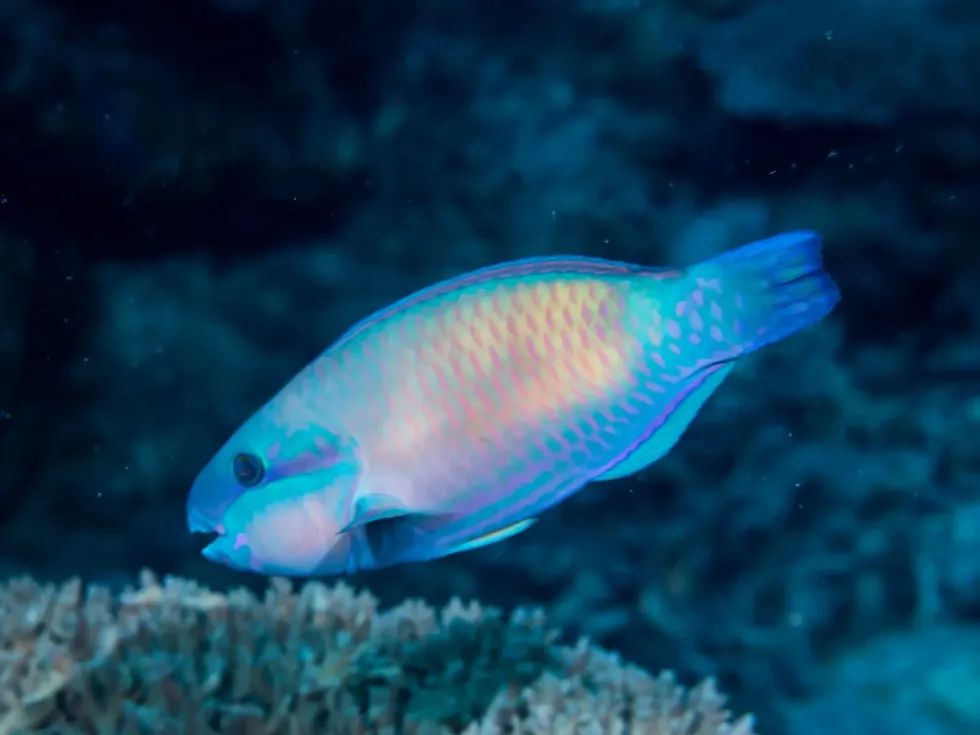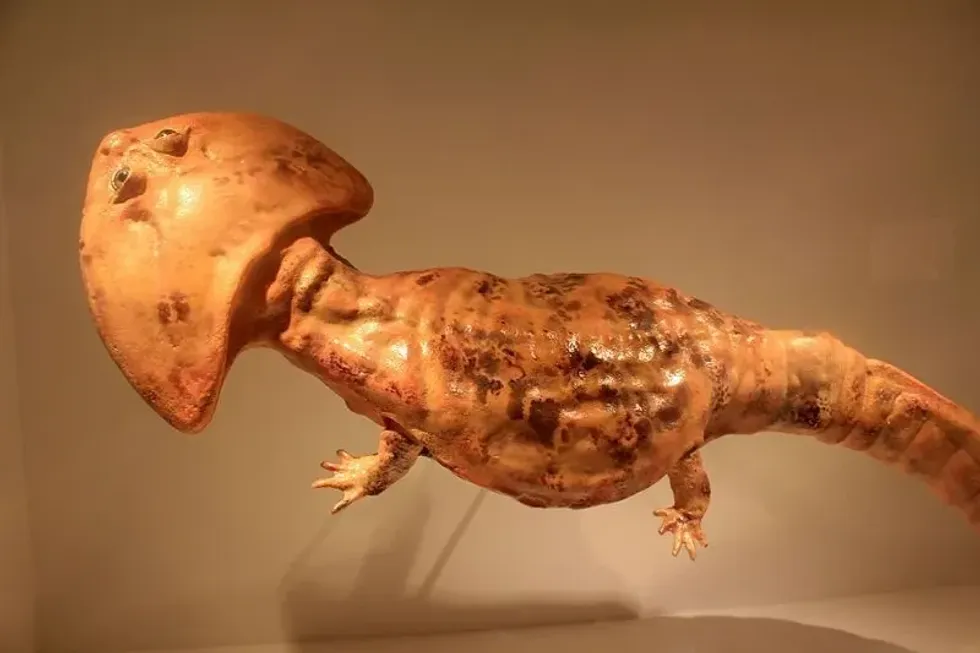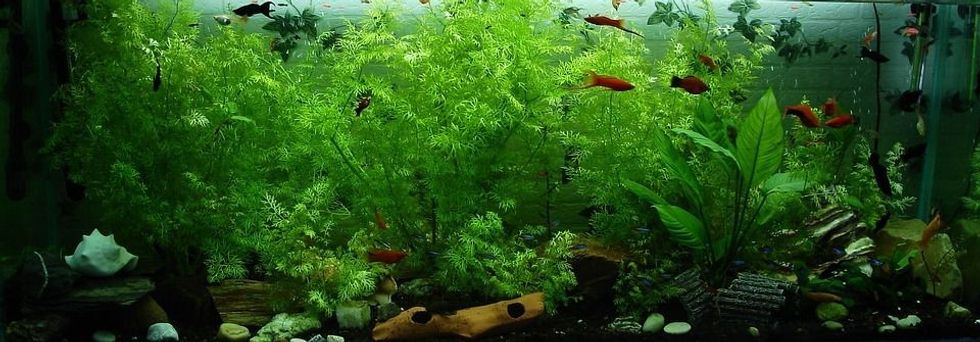Among the 80 parrotfish species, the most common ones are the bullethead parrotfish or daisy parrotfish. Belonging to the family Scaridae, they have region-specific scientific names: Chlorurus sordidus (Indian Ocean) and Chlorurus spilurus (Red Sea).
Their distribution mainly is in the tropical depth of Indian Ocean, Pacific Ocean and Red Sea. With a body length of 15.8 in (40 cm) and a bullet-like head, it can be easily spotted by its blue-green color with white spots.
Marine green algae and reef rubble make up most of their menu. In the later hours of the day, they are found to nap under a reef, forming a cacoon with its mucus as a protective layer.
You can often spot a group of these white-striped fishes in many aquariums, solely kept for education and research purposes. As these form important seafood resources in some countries, data collection is becoming important to reverse the ill effects of overfishing.
Interested to know more about the white-striped daisy parrotfish? Read on for more fun facts.
For more relatable content, check out these bonito fish facts and monkfish facts for kids.
Bullethead Parrotfish Interesting Facts
What type of animal is a bullethead parrotfish?
The bullethead parrotfish is a fish species typical of the tropical waters of the eastern Indian and the Pacific Ocean including the Red Sea. The unique bullet-shaped face of these species has given them their name. Their body color varies throughout their lifetime, changing colors from juvenile to adulthood.
What class of animal does a bullethead parrotfish belong to?
The bullethead parrotfish belongs to the class of Actinopterygii. These fish have ray fins and a bony body structure. Catfish belongs to this class.
How many bullethead parrotfishes are there in the world?
At present, sufficient data on the exact number of blue-green parrotfishes are unavailable. But it is ascertained that there are plenty of fishes in the marine waters.
Where does a bullethead parrotfish live?
The distribution of this tropical fish of the family Scaridae, with the scientific name Chlorurus sordidus, species is found across the eastern Indian Ocean, the Pacific Ocean and the Red Sea. They are easily found near the Tanzanian coast around the coral reefs. They prefer staying in the shallower depths of the sea.
What is a bullethead parrotfish's habitat?
A bullethead parrotfish live in the ocean waters up to 131-164 ft (40-50 m) in depth. They take shelter beneath the coral reef from where food is easily obtainable. They often scale around the oceanic island or coral island in shallower depths. These juvenile fishes are found mostly in the coral reef and lagoons.
Who do bullethead parrotfishes live with?
These bullet-head fish species are known to live both singly and with their groups. While they swim alone all day, but for foraging on their food resources, all of them come together to feed on their food.
Also during the time of spawning, they flock together each looking for its perfect partner. Hence, they live both alone and also with their groups.
How long does a bullethead parrotfish live?
The bullethead parrotfish (Chlorurus sordidus) is known to live for a span of seven years in the Indian Ocean. But data on these fish resources show a decreased life expectancy when kept in aquariums for education, research and public displays as their food menu isn't available.
How do they reproduce?
These fish grow their family by reproducing sexually during the spawning season. The parrotfish bullethead can change their sex throughout their lifetime to mate with the opposite sex.
This means that females may change into males adapting to the new sex in the course of their life. Males and females come together in groups looking for their perfect partner.
Once found, males impregnate females and within few days they lay eggs underneath a reef or an island. Males are found to protect the eggs by forming a layer of cacoon filled with mucus.
The sex at birth of an individual parrotfish is called the primary sex, which may change into secondary sex in their adulthood. So primary females of the initial phase often change into secondary males.
What is their conservation status?
Out of the several variants of the parrotfishes, the bullethead is listed as a species of Least Concern in the IUCN Red List at present. This means their population numbers are not dwindling significantly threatening their existence.
However, data on their commercial exploitation are on the rise in recent years. These fish specimens are relocated from their marine habitat into artificial aquariums for research purpose.
Also, in some countries, they are served as seafood and the increasing demand for these fish resources is threatening their population size. Proper data collection is required to guide the education and conservation efforts for this fish species.
Bullethead Parrotfish Fun Facts

What do bullethead parrotfishes look like?
The body of the medium-sized bullethead parrotfish (Chlorurus sordidus) resembles that of a bullet from the front. The bullet-like head has a parrot-like mouth with sharp protruding teeth looking like a parrot's beak.
The color of their body scales is different in the juvenile and adult stage. In the initial phase, individuals have a black and white striped body with light green colored head having dots on its neck.
In the terminal phase, they turn into new individuals having brightly colored blue and green body with shades of pink spots on the scales. A bullethead parrotfish male has a brighter colored body than a female.
How cute are they?
With a bullet-shaped face and a thin body, this fish looks adorable. The bright blue-green color makes them look extremely cute. The adult ones look cuter than the brown-white juveniles. From the front side, this fish looks like a cute and colorful bullet steadily approaching us.
How do they communicate?
Bulletheads usually refrain from interactions with their own or other related species. But females have been found to be very friendly and prefer staying in groups. One can always spot many females swimming around or foraging on their menu in unison. While males communicate with females only in the time of spawning.
How big is a bullethead parrotfish?
The parrot bullethead (Chlorirus sordidus) is a fish of medium size in length, but its exact height is not ascertained. From its initial phase to terminal phase, its body length reaches up to 15.8 in (40 cm). When compared to a guppy (0.6- 2.4 in), this parrotfish is almost 7-8 times in size.
How fast can a bullethead parrotfish swim?
Both adults and the new juveniles swim very fast in tropical marine waters near a reef. But the exact swimming speed is not yet known.
How much does a bullethead parrotfish weigh?
Data on the exact weight range of these fishes are not yet ascertained.
What are the male and female names of the species?
Separate names are not assigned to the male and female sex of the bullethead parrotfish.
What would you call a baby bullethead parrotfish?
After the eggs hatch, baby bullethead parrotfishes are usually called juveniles.
What do they eat?
The parrotfish is an omnivorous species dependent on both plant and animal sources for obtaining food. Their food consists of green algae, coral, zooplankton and seagrass.
Using their strong bullet-shaped head and teeth, they can easily scrape out algae from the corals. They form groups while feeding and are seen to feed from clouds of marine sediments located near the continental shelf area or underneath the coral reefs.
Are they dangerous?
The Cholorurus sordidus or bullethead parrotfish is not dangerous for human beings. But they are dangerous predators in search of their food menu from the dark ocean depth like the snails, zooplankton and corals.
Would they make a good pet?
The daisy parrotfish should not be kept as pets for home as they live in a marine reef habitat. But often specimens of this and other related fish species are relocated in aquariums for conservation, education and research.
Since the exact marine habitat and menu cannot be replicated at home, it is better to let these marine species live on their own.
Did you know...
The mouth of a single daisy parrotfish is strong enough to cause coral reef and sand erosion up to 80 kg per year only by scraping out with its beak-like teeth from the area of stay.
The bullethead parrotfish coloration is brighter in males than in females.
When primary females change into secondary males, they are known as Supermales.
Two males often fight in the dark hours in search of a larger area under the water. The fight becomes so dangerous that the stronger individual severely injures the weaker with its beak-like teeth.
How did the bullethead parrotfish get its name?
The scientific name bullethead parrotfish (Chlorurus sordidus) has a green scale color and unique beak-like hard teeth on its mouth resembling that of a parrot. Coupled with it, its head is shaped like a bullet, make up for its name. Another subspecies of the Bullethead parrotfish (Red Sea area) is known as Chlorurus spilurus.
How do bullethead parrotfish protect themselves?
Using the bullethead parrotfish mucus cocoon, this fish species protects itself from eels, rays and other potent predators. Also to protect its eggs from getting destroyed the bullethead parrotfish mouth throws out cacoon around the eggs to protect them.
The bullethead parrotfish cacoon is only formed by it at night in the dark. Wrapping itself in cacoon made with mucus from its mouth, it sleeps peacefully in the dark taking refuge mostly under the coral reefs and lagoons.
Here at Kidadl, we have carefully created lots of interesting family-friendly animal facts for everyone to discover! For more relatable content, check out these koi facts and walleye fish facts pages.
You can even occupy yourself at home by coloring in one of our free printable bullethead parrotfish coloring pages.








